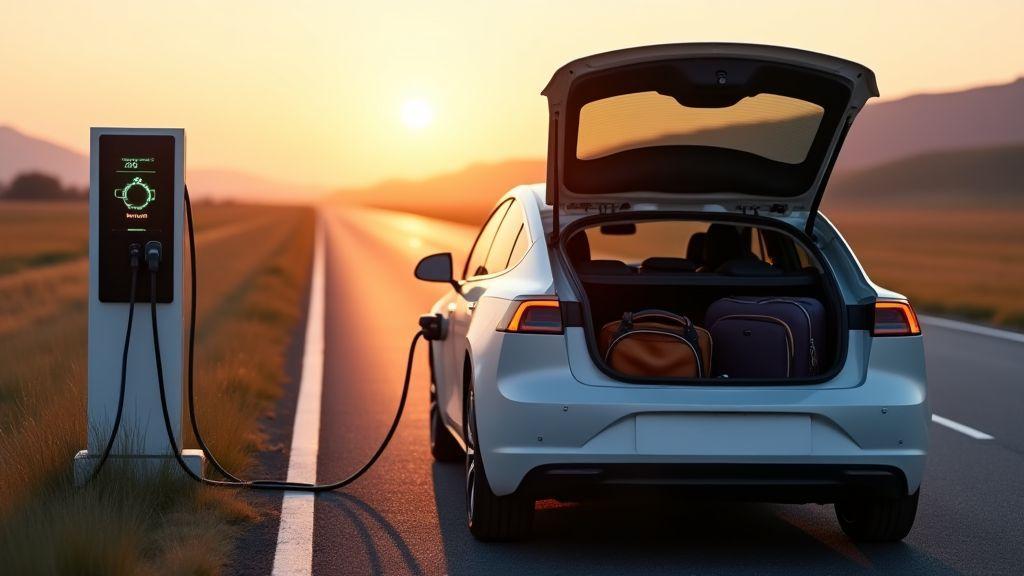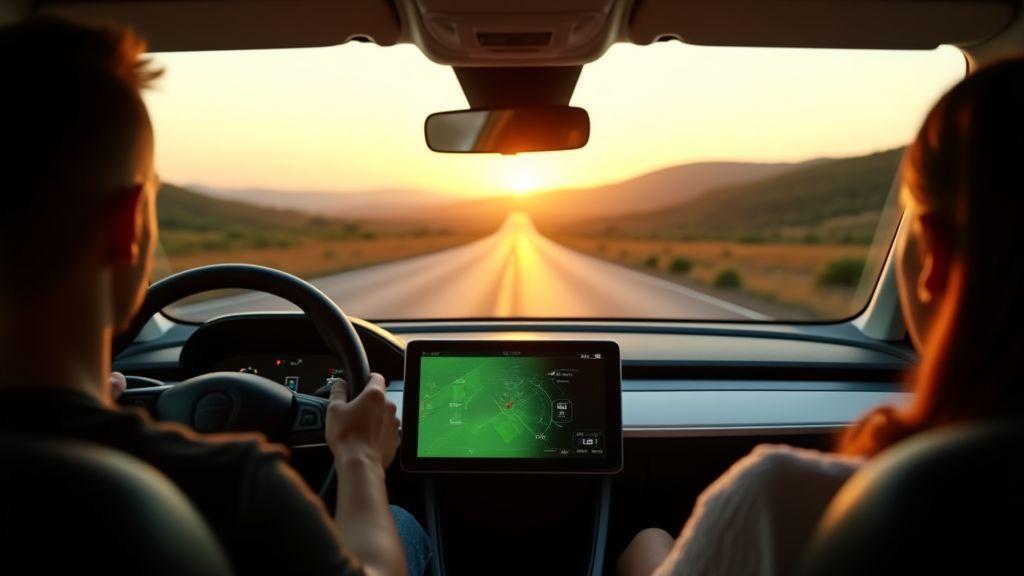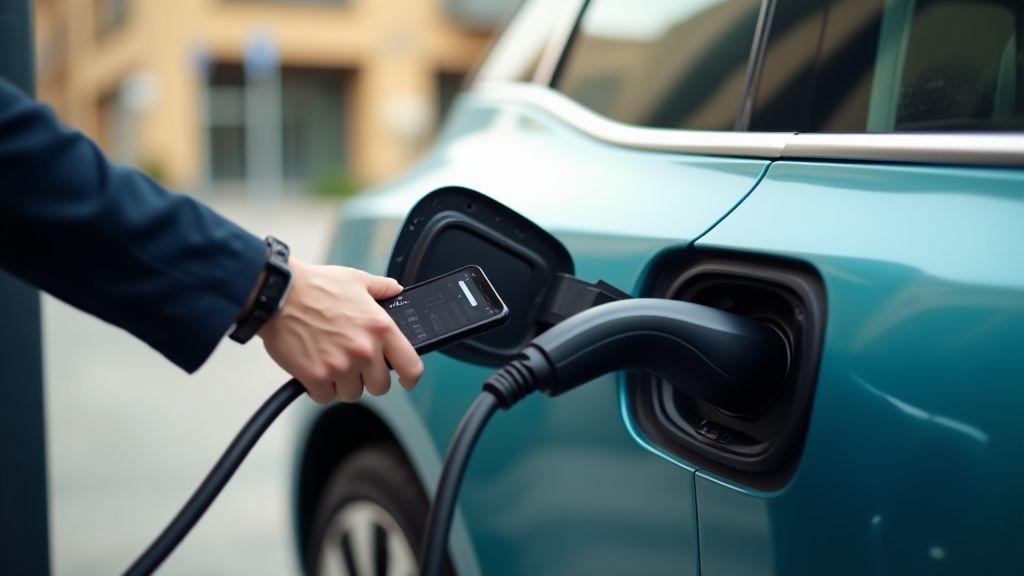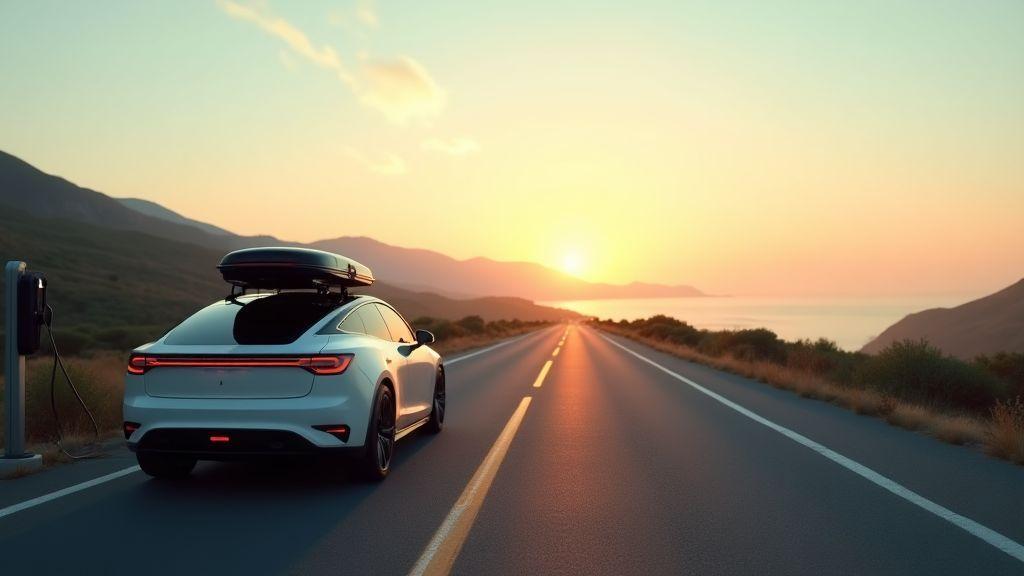How to Plan a Long Road Trip with an Electric Car
This guide shows clear steps to drive far with confidence. You will use apps like ABRP and PlugShare to map chargers and check availability. Set daily mileage goals with a safety buffer and pack cables, adapters, and a portable EVSE. Plan stops based on your real range, drive at steady speeds and use regenerative braking, and cut HVAC use by preconditioning while plugged in. Time charging with meals and sleep, book hotels with destination charging, set up network accounts and backup adapters, and prepare emergency plans for towing and portable charging.
Key Takeaway
- Plan your route to include fast chargers.
- Check charger types and compatibility with your car.
- Know your true range for weather and speed.
- Turn charging stops into rest or meal breaks.
- Bring charging apps, cables, and a backup adapter.

How to Plan a Long Road Trip with an Electric Car: Key Steps
Planning a long road trip in an electric car is like packing for a camping trip: pick the route, map water stops, and bring backups. Start by checking your car’s real-world range—look at recent trips, weather, and how fast you drive. Pick corridors with reliable chargers and build breathing room into every leg.
Treat charging as part of the trip. Charging adds pauses; use them to eat, stretch, and explore. Overnight Level 2 charging at a hotel saves time the next day. Remember that cold, heat, and hills can cut range—build that into your timing.
Sort membership cards, payment apps, and support numbers before you go. Carry screenshots and at least one fallback charger mapped for each leg. With a clear route, realistic daily miles, and backup options, the trip stays smooth rather than stressful.
Use apps to map chargers and plan stops so you know where to charge
Apps are your co-pilot. Use PlugShare for station notes, ABRP (A Better Routeplanner) to model range and stops, and network apps (ChargePoint, EVgo, Electrify America) for real-time availability. The U.S. Department of Energy also hosts an Official EV charging station locator tool useful for filtering by connector and speed. Filter by connector type and charging speed; read recent user comments for broken stalls or blocked access.
Cross-check sources for each stop and save backup locations and addresses as text. If a station is busy, have a second or third option within 10–15 miles to avoid scrambling.
Tool comparison:
| Tool | Strength | When to Use |
|---|---|---|
| ABRP | Vehicle-specific range modeling and optimized stops | When you need a detailed plan that factors elevation, weather, and speed |
| PlugShare | Live user reports, photos, station notes | When you want up-to-date status, payment notes, or station layout photos |
Charger types (typical):
| Charger type | Common connector | Typical charging gain (miles/hr) |
|---|---|---|
| Level 1 (120V) | Standard household | 3–5 |
| Level 2 (240V) | J1772 / Type 2 | 20–30 |
| DC Fast | CCS / CHAdeMO / Tesla Supercharger | 150–200 |
Set a daily mileage goal and add a safety buffer for range
Decide daily miles, then shave that number down. If your car shows 250 miles range, plan on 150–180 miles per day to allow for weather, detours, or traffic. For short highway hops, top up to ~80% at fast chargers; for overnight, charge to ~90% if you need extra reach the next morning. Always try to leave with at least 20% as a buffer.
Pack charging cables, adapters, and a portable EVSE
Bring the essentials so you can use whatever charger you find:
- OEM mobile connector (always)
- Portable Level 2 EVSE with common NEMA adapters
- CCS or CHAdeMO adapter if your car needs them
- Network RFID cards or payment apps preloaded
- Small bag for cables and gloves
Plan your route with EV charging station route planning and availability forecasting
Match your real range to chargers and build breathing room into every leg. Use planners that factor elevation, weather, and speed. Forecasts of station availability (based on historical use and time of day) help you choose stations with more stalls or faster power.
Pick stops near food, bathrooms, or parks. If on a tight schedule, choose fast chargers and keep top-ups shallow. Each stop should move you forward in both time and charge.
Place charging stops based on your car’s real range and local charger locations
Measure your true average range in conditions similar to your trip. If you normally get 180 miles, plan legs at 60–75% of that on long trips, especially in cold/hilly areas. Prefer stations with multiple fast bays and reliable networks. For overnight, find hotels with Level 2 chargers to save a fast-charge stop.
Confirm connector types and live availability before driving
Verify connector type and live status in the app. Check if a station uses CCS, CHAdeMO, or Tesla plug and whether you need an adapter or specific payment card. Look at recent user reports to avoid dead or blocked chargers.

Manage EV range on long trips using energy efficient driving techniques
Think of your battery like a picnic cooler—small choices add up. How fast you drive, how you brake, and whether you pre-warm the cabin matter. Treat energy use as part of the route. For more detail on small changes that add up, see federal Energy-saving driving tips for electric vehicles for practical advice on speed, HVAC, and braking.
Break your route into charging legs that match realistic speed and weather. Heavy cargo, roof racks, and high speeds eat range; so do hills. Watch instant consumption and learn which speeds give the best miles per kWh.
Drive steady, use cruise control
Steady speeds reduce drag. Holding 65 mph instead of 75 mph can save a lot of energy. Use cruise control on highways with light traffic; adaptive cruise reduces sudden speed changes.
| Speed (mph) | Relative energy use | Estimated range change vs 55 mph |
|---|---|---|
| 55 | Low | baseline |
| 65 | Moderate | ~10–15% less range |
| 75 | High | ~20–35% less range |
Values vary by vehicle, wind, and terrain—use your car’s display to refine numbers.
Limit rapid acceleration and use regenerative braking
Hard acceleration drains energy fast. Ease onto the pedal when merging or passing. Use stronger regen settings and anticipate stops to recapture energy. One-pedal driving can significantly reduce consumption in stop-and-go conditions.
Reduce HVAC use and pre-condition while plugged in
Pre-condition the cabin while charging so you use wall power for heating/cooling. Use seat and steering wheel heaters instead of full-cabin heat; they use far less energy.
Steps:
- Plug in and pre-set cabin temperature via app or car menu.
- Disconnect once comfortable and battery is charged.
- Use seat heaters and directional vents to reduce HVAC load while driving.
Optimize charging time and plan EV stops and accommodations
Charge where you rest. Pick chargers that match your car’s charge rate and place them where you will eat, stretch, or sleep. The Federal Highway Administration offers Guidance on planning highway EV charging for siting chargers and rest-area integration. Map backup chargers within 10–20 miles of each main stop.
- Pick main chargers that hit your car’s peak rate.
- Schedule overnight stays with Level 2 or destination chargers.
- Add one backup charger near each stop and plan activities that match charging time.
Charge to ~80% on DC fast chargers to save time
Most EVs charge rapidly to ~80%, then slow. Stopping around 80% is usually the fastest strategy unless you need full range.
| Charger type | 20% → 80% (approx.) | 20% → 100% (approx.) | Extra minutes for 80→100 |
|---|---|---|---|
| 50 kW DC | 45–60 min | 90–120 min | 45–60 min |
| 150 kW DC | 20–30 min | 40–60 min | 20–30 min |
| 250 kW DC | 12–18 min | 25–40 min | 12–22 min |
Charge to 100% when you face long chargerless stretches, mountain drives, or must arrive full.
Book hotels with Level 2 or destination charging
A Level 2 charger adds ~20–40 miles per hour. Most overnights give you a nearly full day of driving. Call ahead to confirm charger type, parking rules, and whether you need an adapter.
Align charging with meals, walks, or sleep
Match charging windows to real activities—eat, hike, or sleep while the car charges. This minimizes downtime.

Check charging network compatibility, adapters, and payment setup
Know which networks your route uses. Compare coverage along the entire route—some networks are dense in cities but thin in rural stretches. Match charger speed to your battery size and daily miles.
Check connector types and adapters
Most newer EVs use CCS; older models may use CHAdeMO. Tesla uses its own connector in the U.S. and offers adapters. Know which plug your car needs at each stop and carry necessary adapters. Some adapter combinations limit charging speed—verify compatibility. For technical background on CCS and interoperability, see this industry Overview of CCS and connector standards resource.
| Connector | Common regions | Typical car examples | Adapter needed? |
|---|---|---|---|
| CCS (Combo) | Europe, North America | VW, BMW, Ford, Hyundai | No for most modern EVs |
| CHAdeMO | Japan, some regions worldwide | Nissan Leaf (older), Mitsubishi | Yes for CCS cars |
| Tesla (proprietary) | North America (Tesla) | Tesla Model S/3/X/Y | Yes to use non-Tesla chargers |
Set up accounts and payment methods
Create accounts on networks you expect to use (Electrify America, ChargePoint, EVgo, local providers). Register before you go and add payment methods — and review the networks’ terms of use when needed. Some stations require apps or RFID—test at a local charger before the trip. Save login details or use a password manager, and refer to our privacy policy for guidance on managing account data.
- Download network apps and create accounts.
- Add and verify a payment method.
- Store login details and test at a nearby charger.
Carry backup adapters, RFID cards, and offline screenshots of station IDs or QR codes as a tech safety net.
Build a trip itinerary for electric vehicles and range-anxiety solutions
Treat your route as a chain of short, safe hops. Break each day into planned legs based on real-world range with a generous buffer. Factor charger types, speeds, elevation, and likely delays. Use apps and maps to lock down primary and alternate chargers for each leg. Where possible, book overnight charging so you start each day fuller.
Suggested buffer table:
| Daily leg length | Suggested buffer (miles) | Target arrival SoC |
|---|---|---|
| Under 75 miles | 10–20 miles | 50% |
| 75–200 miles | 20–40 miles | 40% |
| Over 200 miles | 40 miles or split into two legs | 30–40% |
Plan each driving day with concrete numbers: distance, buffer, charger make/model, connector, and expected kW. Save offline maps and screenshots in case cell service drops.
- Map your route, check charger types and speeds, and pick a primary and an alternate for every stop.
Prepare emergency plans: roadside EV towing, portable chargers, and contacts
Know which tow companies handle EVs and require flatbeds; see Towing and roadside assistance for EVs for specifics on flatbed requirements. Store their numbers and membership service contacts in your phone and on paper — and note local assistance resources via our contact page. Ask your insurer about EV-trained tow operators.
Carry small items that can save you time: an emergency phone charger, basic adapter set, and a portable Level 1 charger for rural stretches (it will be slow). Save charging network phone numbers, nearby hotels with chargers, and your carmaker’s roadside assistance contact. If you run low, call help and state you drive an EV so they send the right gear.
Track battery health, tire pressure, and charging performance during the trip
Check tire pressure every morning and after long legs—low pressure cuts range quickly. Log charging sessions: start SoC, end SoC, kW delivered, and time to charge. That log helps spot underperforming chargers or charging-acceptance drops so you can adapt early.
Planning checklist: How to Plan a Long Road Trip with an Electric Car
- Verify true real-world range for expected conditions.
- Map chargers with ABRP and PlugShare; save alternates as text.
- Pack cables, adapters, portable EVSE, RFID cards, and a small tools bag.
- Pre-register on charging networks and add payment methods.
- Book hotels with Level 2 or destination charging when possible.
- Plan legs with a safety buffer and target arrival SoC.
- Align charging with meals and sleep; aim for ~80% on DC fast chargers.
- Know tow contacts, carry emergency gear, and log charging performance daily.
Conclusion
Plan deliberately, use the right apps (ABRP and PlugShare), and build a safety buffer into your range. Treat charging stops like pit stops—time them with meals or sleep and make them work for you. Pack essentials (cables, adapters, portable EVSE), confirm connector types and network accounts, and carry physical backups—screenshots, RFID cards, and towing contacts.
Drive steady: gentle acceleration, regenerative braking, and pre-conditioning while plugged in stretch every mile. Charge to about 80% at DC fast chargers unless you need the last 20%. Map primary and backup chargers for each leg and check tire pressure and battery behavior daily. With realistic daily miles, redundant plans, and the right gear, range anxiety fades and the trip becomes a series of smooth, manageable hops.
Ready to plan your next trip with confidence? Read more on the Meridian Pioneer home page.

